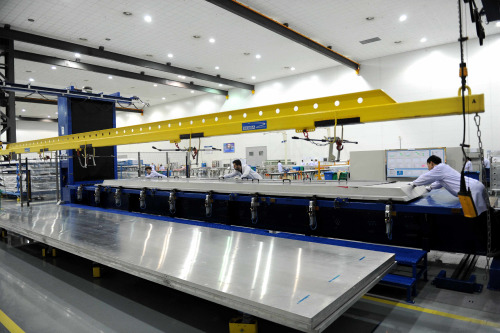
Workers operate a machine in a workshop of the Hafei Airbus Composite Manufacturing Center in Harbin, capital of northeast China's Heilongjiang Province, on December 12, 2014 (XINHUA)
In the first quarter of this year, Liaoning's economy only expanded 1.9 percent over the previous year, ranking it last among all of the provinces, municipalities and autonomous regions on the Chinese mainland. Heilongjiang, Jilin and Liaoning respectively registered 5.1 percent, 6.1 percent and 2.6 percent for GDP growth on an annual basis from January to June, still slower than the national average of 7 percent.
Fiscal revenues have also shrunk. In January to June, the fiscal revenue of Liaoning declined 22.7 percent year on year. In the first five months, the fiscal revenues of Heilongjiang and Jilin provinces shrank by 19 percent and 5.9 percent from a year earlier, respectively.
Feng Lei, a researcher with the Economic Development Research Center under the Chinese Academy of Social Sciences (CASS), said that the three northeastern provinces have similar economic structures--all dominated by equipment manufacturing, petrochemical and agricultural industries.
"This kind of industrial structure is extremely vulnerable to outside changes, such as a decline in commodity demand and prices in the international market," Feng said.
Worse still, the population of the three provinces is shrinking due to migration and extremely low fertility rates, which experts maintained will severely hinder local economic recovery.
According to the 2010 national census, about 1.8 million people had moved out of the provinces of Heilongjiang, Jilin and Liaoning, in search of better job opportunities in the economically developed eastern and southern regions.
The results of the census also showed that the three provinces registered the lowest fertility rates in the country--0.74 in Liaoning, 0.75 in Heilongjiang and 0.76 in Jilin, far below the 2.1 generally considered to be the level at which the population would be replenished.
According to Wang Guangzhou, a researcher with the CASS Institute of Population and Labor Economics, the northeastern region has been trapped in a vicious circle.
"Sluggish economic growth has caused talent outflow, and that will in turn worsen the already challenged economy," Wang said.
Xu Hongwei, an assistant researcher with the Research Institute for Economic and Social Development with Dongbei University of Finance and Economics in Dalian, Liaoning, revealed that the aging problem is more pronounced in northeast China than in any other part of the country.
"More and more young people left the region in quest of better job opportunities. That, combined with the low fertility rate, makes the aging problem extremely severe in the northeastern region," Xu said. "In the future, some universities in the region will have difficulty in recruiting enough students because there simply aren't enough candidates."


















































